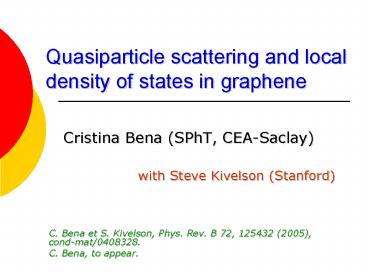Quasiparticle scattering and local density of states in graphene - PowerPoint PPT Presentation
1 / 14
Title:
Quasiparticle scattering and local density of states in graphene
Description:
Quasiparticle scattering and local density of states in graphene. Cristina Bena (SPhT, CEA-Saclay) ... T-matrix calculation for the LDOS and FTSTS spectra ... – PowerPoint PPT presentation
Number of Views:293
Avg rating:3.0/5.0
Title: Quasiparticle scattering and local density of states in graphene
1
Quasiparticle scattering and local density of
states in graphene
- Cristina Bena (SPhT, CEA-Saclay)
- with Steve Kivelson (Stanford)
C. Bena et S. Kivelson, Phys. Rev. B 72, 125432
(2005), cond-mat/0408328. C. Bena, to appear.
2
Outline
- Graphene band structure
- Local density of states (LDOS) and Fourier
transform scanning tunneling spectroscopy (FTSTS) - Intuitive arguments for FTSTS
- T-matrix calculation for the LDOS and FTSTS
spectra
3
Graphene band structure
- Tight binding Hamiltonian
- Band structure
ca
b3
b2
b1
cb
4
Graphene band structure
- Hexagonal Brillouin zone
- Zero energy corners of BZ
- Higher energies lines (circles, triangles,
hexagons) - Fermi points ? nodal quasiparticles with linear
dispersion
5
Scanning tunneling microscopy (STM) measurements
- Density of states as a function of energy and
position ?(x,E) - At each position ?(E)
- Fixed energy E, scan entire sample ? ?(x)
- Analyze ?(x) take Fourier transform (FTSTS) ?
patterns
6
Density of states in the absence of impurity
scattering
- Uniform in space
- Free Greens function
- Spectral function
- Density of states
TrG(k,E)
7
Impurity scattering
- Intuitive picture
- Impurity generates scattering between
quasiparticles with same energy - Corresponding Friedel oscillations in the LDOS
with wavevectors given by change in momenta of
quasiparticles - FTSTS spectra ? peaks at wavevectors
corresponding to scattering
8
Impurity scattering potential
- Local (delta-function) in space ? uniform in
momentum - Single site scattering (sublattice basis)
- Uniform interband (diagonal sub-band basis)
U0Ca (x) Ca (x) d(x)?U0Ca (k1) Ca (k2)
9
T-matrix approximation
Greens function in imaginary time
T
G0(k2)
G0(k1)
T-matrix approximation
G(k1,k2)
TrIm
)
10
T-matrix approximation
T
V
V
V
G0
For V independent of k
11
Results FTSTS spectra
- Low energy ? high intensity points (scattering
between corners of BZ) - Higher energy ? high intensity lines
- Shape of lines depends on energy (circles,
triangles, hexagons)
12
Friedel oscillations (LDOS)
- Undoped graphene
- Oscillations in LDOS at a specific energy
- Strongly dependent on form of impurity scattering
- 1/r (C. Bena, S. Kivelson,
- PRB 2005),
- 1/r2 (V. Cheianov, V. Falko
- PRL 2006)
- (linearized band structure)
- 1/r2 (C. Bena to appear)
- (full band structure)
- Friedel oscillations in
- total charge depend
- on doping and have
- extra factor of 1/r
?0.5 eV
13
Impurity resonances
- Average LDOS
- Also LDOS at impurity site, or on a neighboring
site - Impurity ? low energy resonance
V2.5eV
V8
14
Conclusions and future directions
- Lines of high intensity in FTSTS spectra due to
impurity scattering - STM measurements on graphene could reveal physics
at all energies - Test Fermi liquid picture
- Other type of impurities (Coulomb) may yield
different physics.































